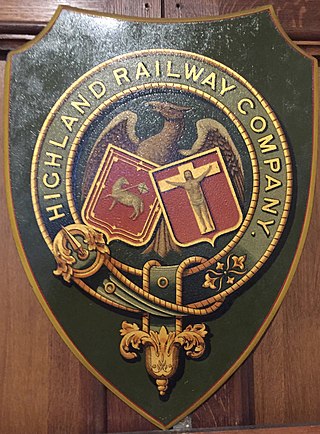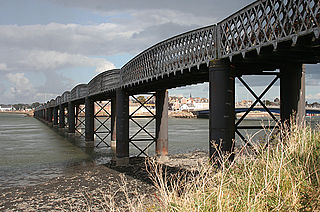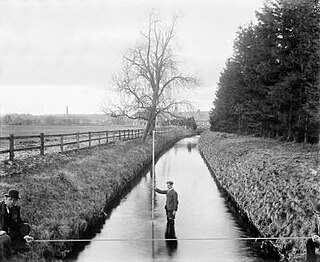
Perth is a centrally located Scottish city, on the banks of the River Tay. It is the administrative centre of Perth and Kinross council area and is the historic county town of Perthshire. It had a population of about 47,430 in 2018.

The Tay Bridge carries rail traffic across the Firth of Tay in Scotland between Dundee and the suburb of Wormit in Fife. Its span is 2.75 miles. It is the second bridge to occupy the site.

The Highland Railway (HR) was one of the smaller British railways before the Railways Act 1921, operating north of Perth railway station in Scotland and serving the farthest north of Britain. Based in Inverness, the company was formed by merger in 1865, absorbing over 249 miles (401 km) of line. It continued to expand, reaching Wick and Thurso in the north and Kyle of Lochalsh in the west, eventually serving the counties of Caithness, Sutherland, Ross & Cromarty, Inverness, Perth, Nairn, Moray and Banff. Southward it connected with the Caledonian Railway at Stanley Junction, north of Perth, and eastward with the Great North of Scotland Railway at Boat of Garten, Elgin, Keith and Portessie.

The Glenfinnan Viaduct is a railway viaduct on the West Highland Line in Glenfinnan, Inverness-shire, Scotland, built from 1897 to 1901. Located at the top of Loch Shiel in the West Scottish Highlands, the viaduct overlooks the Glenfinnan Monument and the waters of Loch Shiel.

Dunkeld is a town in Perth and Kinross, Scotland. The location of a historic cathedral, it lies on the north bank of the River Tay, opposite Birnam. Dunkeld lies close to the geological Highland Boundary Fault, and is frequently described as the "Gateway to the Highlands" due to its position on the main road and rail lines north. Dunkeld has a railway station, Dunkeld & Birnam, on the Highland Main Line, and is about 25 kilometres north of Perth on what is now the A9 road. The main road formerly ran through the town, however following modernisation of this road it now passes to the west of Dunkeld.

Dalguise is a settlement in Perth and Kinross, Scotland. It is situated on the western side of the River Tay on the B898 road, 5 miles north of Dunkeld. Located there is Dalguise House, a place where, from the age of four, Beatrix Potter stayed annually with her family throughout the summer, from May till the end of the salmon season.
The Perth and Dunkeld Railway was a Scottish railway company. It was built from a junction with the Scottish Midland Junction Railway at Stanley, north of Perth, to a terminus at Birnam, on the south bank of the River Tay opposite Dunkeld.

Moncreiffe Island, also known as Friarton Island, is an island in Perth, Scotland. It divides the River Tay into two channels as it flows through Perth, and is crossed by the single-track Tay Viaduct, carrying the Scottish Central Railway.
The Newburgh and North Fife Railway was a Scottish railway company formed to build a connecting line between St Fort and Newburgh, in Fife, intended to open up residential traffic between the intermediate communities and Dundee and Perth. It opened its line, which was expensive to construct, in 1909 but the local traffic never developed. It closed to passenger traffic in 1951, and completely in 1964.
Bertha is the name of the site of a Roman fort north of the site of modern Perth, Scotland, at the confluence of the rivers Almond and Tay. It is 0.5 miles (0.80 km) east of the modern farm of "Berthapark" and is a scheduled ancient monument.

Dalguise railway station served the Scottish settlement of Dalguise, Perth and Kinross, from 1863 to 1965 on the Inverness and Perth Junction Railway.

The Devon Valley Railway linked Alloa and Kinross in central Scotland, along a route following the valley of the River Devon. Its construction took 20 years from the first section opening in 1851, to the final section in 1871. Three railway companies were involved, and it encountered a great many problems both with finance and engineering.

The North British, Arbroath and Montrose Railway was a company established by Act of Parliament in 1871 to construct and operate a railway line from north of Arbroath via Montrose to Kinnaber Junction, 38 miles (61 km) south of Aberdeen. The company was originally a subsidiary of the North British Railway but was absorbed into its parent in 1880.
Events from the year 1848 in Scotland.

The Shin Railway Viaduct is a railway viaduct that crosses the Kyle of Sutherland.The viaduct carries the Far North Line between Inverness and Wick and Thurso. Invershin railway station is at the north-eastern end of the viaduct, while Culrain railway station is a short distance to the south.

Perth Lade is an historic 4.5 mi (7.2 km)-long watercourse in Perth and Kinross, Scotland. Created in the 11th century or earlier, it has been used to power several watermills, such as those that functioned at Perth's Lower City Mills, which have existed since the 18th century. Over its course, at least nineteen industrial sites existed; today, the remains of nine of these can be seen, the rest lost to inner-city development and housing schemes of the 20th and 21st centuries. A footpath follows the majority of the lade's course.

Tay Street is a major thoroughfare, part of the A989, in the Scottish city of Perth, Perth and Kinross. Planned in 1806 and completed around 1885, it is named for the River Tay, Scotland's longest river, on the western banks of which it sits. The street runs from the confluence of West Bridge Street and Charlotte Street in the north to a roundabout at Marshall Place and Shore Road in the south. Three of the city's four bridges that cross the Tay do so in this stretch : Perth Bridge, Queen's Bridge and the single-track Tay Viaduct, carrying Perth and Dundee trains to and from Perth railway station, located 0.5 miles (0.80 km) to the north-west.

The Tay Viaduct, also known as the West Railway Bridge, is a single-track railway viaduct in Perth, Perth and Kinross, Scotland. It is around 440 m (1,440 ft) long. It carries the Scottish Central Railway, via a pronounced curve, across the River Tay to and from Perth railway station, 0.5 mi (800 m) to the west. Built in 1864, the work of London's Francis Freeman & Lee, it replaced an earlier double-track timber viaduct dating from 1849. The first pier of today's structure is for a double track, but the line is now single.
















